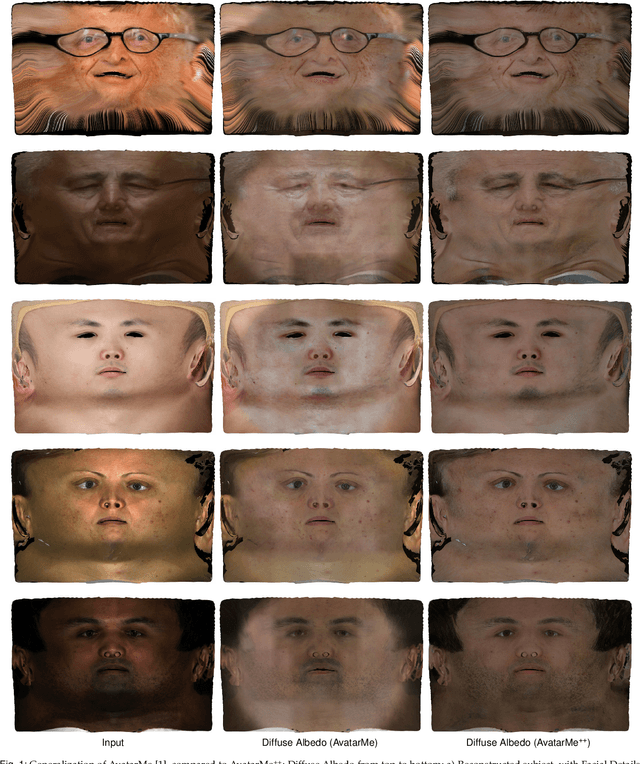Abhijeet Ghosh
AvatarMe++: Facial Shape and BRDF Inference with Photorealistic Rendering-Aware GANs
Dec 11, 2021



Abstract:Over the last years, many face analysis tasks have accomplished astounding performance, with applications including face generation and 3D face reconstruction from a single "in-the-wild" image. Nevertheless, to the best of our knowledge, there is no method which can produce render-ready high-resolution 3D faces from "in-the-wild" images and this can be attributed to the: (a) scarcity of available data for training, and (b) lack of robust methodologies that can successfully be applied on very high-resolution data. In this work, we introduce the first method that is able to reconstruct photorealistic render-ready 3D facial geometry and BRDF from a single "in-the-wild" image. We capture a large dataset of facial shape and reflectance, which we have made public. We define a fast facial photorealistic differentiable rendering methodology with accurate facial skin diffuse and specular reflection, self-occlusion and subsurface scattering approximation. With this, we train a network that disentangles the facial diffuse and specular BRDF components from a shape and texture with baked illumination, reconstructed with a state-of-the-art 3DMM fitting method. Our method outperforms the existing arts by a significant margin and reconstructs high-resolution 3D faces from a single low-resolution image, that can be rendered in various applications, and bridge the uncanny valley.
Deep Polarization Imaging for 3D shape and SVBRDF Acquisition
May 06, 2021



Abstract:We present a novel method for efficient acquisition of shape and spatially varying reflectance of 3D objects using polarization cues. Unlike previous works that have exploited polarization to estimate material or object appearance under certain constraints (known shape or multiview acquisition), we lift such restrictions by coupling polarization imaging with deep learning to achieve high quality estimate of 3D object shape (surface normals and depth) and SVBRDF using single-view polarization imaging under frontal flash illumination. In addition to acquired polarization images, we provide our deep network with strong novel cues related to shape and reflectance, in the form of a normalized Stokes map and an estimate of diffuse color. We additionally describe modifications to network architecture and training loss which provide further qualitative improvements. We demonstrate our approach to achieve superior results compared to recent works employing deep learning in conjunction with flash illumination.
AvatarMe: Realistically Renderable 3D Facial Reconstruction "in-the-wild"
Mar 30, 2020



Abstract:Over the last years, with the advent of Generative Adversarial Networks (GANs), many face analysis tasks have accomplished astounding performance, with applications including, but not limited to, face generation and 3D face reconstruction from a single "in-the-wild" image. Nevertheless, to the best of our knowledge, there is no method which can produce high-resolution photorealistic 3D faces from "in-the-wild" images and this can be attributed to the: (a) scarcity of available data for training, and (b) lack of robust methodologies that can successfully be applied on very high-resolution data. In this paper, we introduce AvatarMe, the first method that is able to reconstruct photorealistic 3D faces from a single "in-the-wild" image with an increasing level of detail. To achieve this, we capture a large dataset of facial shape and reflectance and build on a state-of-the-art 3D texture and shape reconstruction method and successively refine its results, while generating the per-pixel diffuse and specular components that are required for realistic rendering. As we demonstrate in a series of qualitative and quantitative experiments, AvatarMe outperforms the existing arts by a significant margin and reconstructs authentic, 4K by 6K-resolution 3D faces from a single low-resolution image that, for the first time, bridges the uncanny valley.
 Add to Chrome
Add to Chrome Add to Firefox
Add to Firefox Add to Edge
Add to Edge